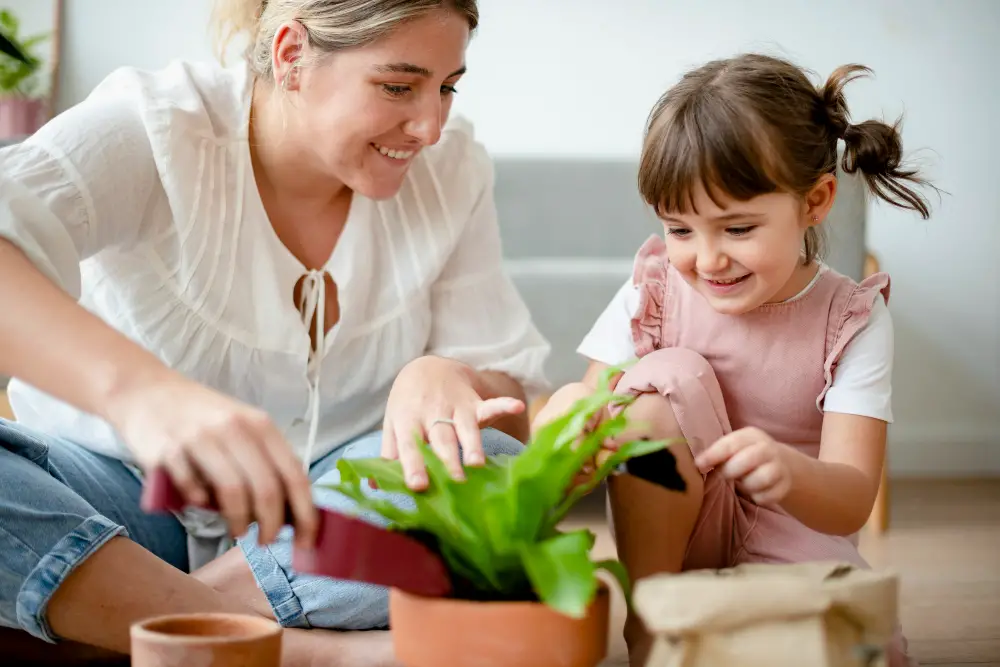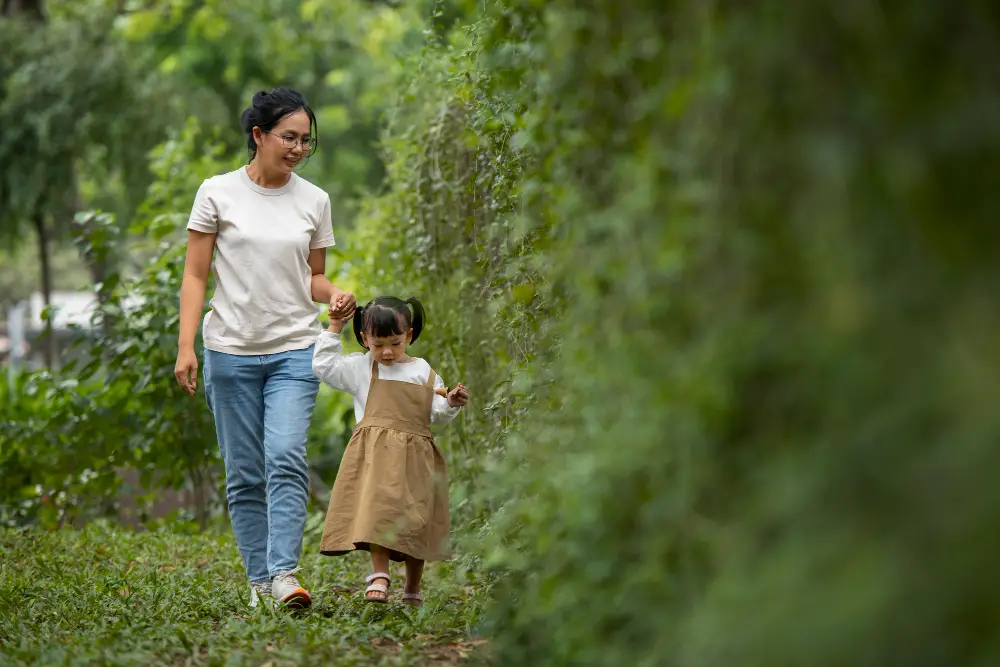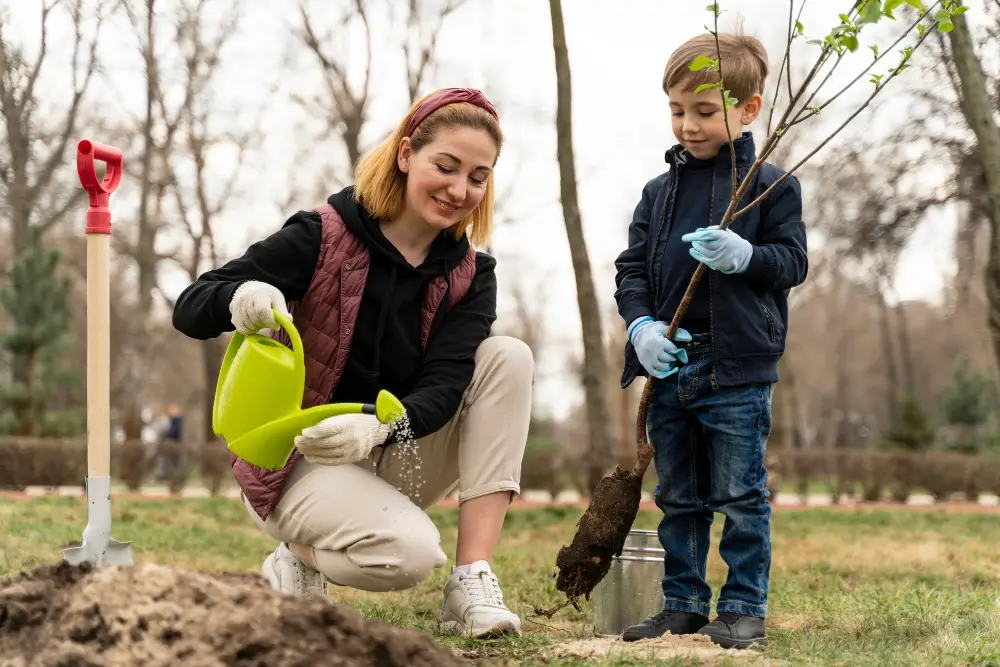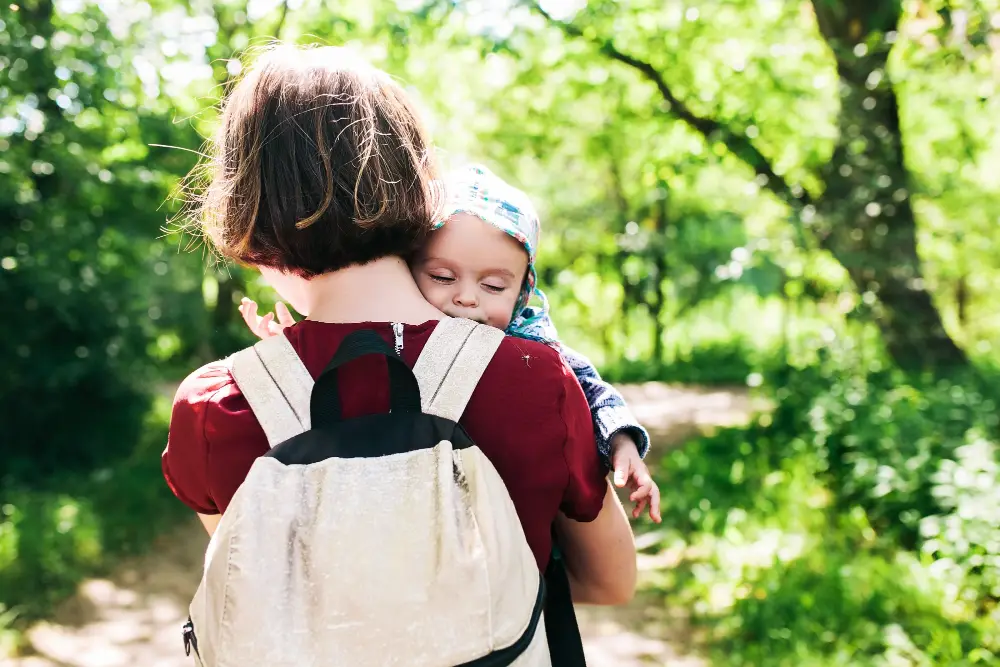Eco-Friendly Parenting: Nurturing a Sustainable Future
In this article, we will explore eco-friendly parenting tips to help you raise your child in a sustainable manner. By incorporating environmentally conscious practices into your daily life, you can contribute to a greener future for your children. Let’s start with creating an eco-friendly home environment.

Creating an Eco-Friendly Home Environment for Green Parenting
Creating a sustainable home environment is a crucial step towards eco-friendly parenting. By adopting eco-conscious practices, you can reduce your carbon footprint and teach your children the importance of environmental responsibility.
Embrace Sustainable Living
Embracing sustainable living involves making conscious choices that minimize negative impacts on the environment. Here are some tips to help you embrace sustainable living in your home:
- Conserve energy: Turn off lights when not in use, unplug electronic devices, and consider investing in energy-efficient appliances.
- Opt for renewable energy sources: Explore solar panels or wind turbines as alternative energy sources for your home.
- Conserve water: Fix leaks, install low-flow faucets and showerheads, and use water wisely in daily activities.
Implement Energy-Saving Practices
Implementing energy-saving practices not only reduces your energy consumption but also saves you money. Here are some energy-saving tips for an eco-friendly home:
- Switch to LED light bulbs: LED bulbs are energy-efficient and have a longer lifespan than traditional incandescent bulbs.
- Use natural light: Make the most of natural daylight by opening curtains and blinds during the day.
- Set your thermostat wisely: Adjust your thermostat to conserve energy while maintaining a comfortable temperature.
Reduce, Reuse, Recycle: A Green Lifestyle Approach
Adopting a green lifestyle approach that involves reducing waste, reusing items, and recycling is essential for eco-friendly parenting. Here are some practices to incorporate:
- Reduce waste: Avoid single-use items, opt for reusable alternatives like cloth diapers, and minimize packaging waste by buying in bulk.
- Reuse items: Give new life to old items through upcycling or donating them to others in need.
- Recycle properly: Familiarize yourself with local recycling guidelines, sort and clean recyclables correctly, and encourage your children to participate in recycling efforts.
By implementing these eco-friendly practices in your home, you are not only reducing your environmental impact but also teaching your children the importance of sustainable living.
Remember, small changes can make a big difference, and as parents, we have the power to shape a sustainable future for our children through eco-friendly parenting practices. Stay tuned for the next sections, where we will explore more tips on raising eco-conscious kids, nourishing the earth and your child, sustainable wardrobe choices, eco-friendly travel, minimalism, mindful consumption, and teaching environmental stewardship.
Raising Eco-Conscious Kids
As parents, one of the most impactful ways to foster a sustainable future is by raising eco-conscious kids. By instilling a love for nature and teaching them environmental responsibility, we can empower our children to become advocates for the planet.
Foster a Love for Nature
Fostering a love for nature in children helps develop their connection with the environment and cultivates a sense of stewardship. Here’s how you can nurture this love for nature:
- Spend time outdoors: Encourage outdoor activities like hiking, gardening, or simply exploring local parks. This allows children to experience the beauty of nature firsthand.
- Encourage curiosity: Teach your children about different plants, animals, and ecosystems. Engage in nature-related discussions and answer their questions to enhance their understanding and appreciation.
- Nature-based play: Incorporate nature-inspired toys, books, and games that promote environmental awareness and conservation.
Connect with the Outdoors: Exploring the Wonders of Nature
Connecting with the outdoors is vital for children’s physical and mental well-being. Here are some ways to enhance their outdoor experiences:
- Nature walks and hikes: Take your children on nature walks or family hikes to explore natural landscapes, observe wildlife, and appreciate the diversity of flora and fauna.
- Camping and outdoor adventures: Plan camping trips or outdoor adventures where your children can engage in activities like star-gazing, storytelling around a campfire, or learning outdoor survival skills.
- Beach cleanups and nature volunteering: Participate in community events that focus on environmental conservation, such as beach cleanups or local nature reserve volunteering programs. These activities teach children the importance of taking care of their surroundings.
Teach Environmental Responsibility: Empowering Kids to Make a Difference
Empowering children to make a positive impact on the environment instills a sense of responsibility and the belief that their actions matter. Here are some ways to teach environmental responsibility:
- Lead by example: Be a role model by demonstrating eco-friendly habits and sustainable choices in your daily life. Children learn best through observation and imitation.
- Involve them in eco-friendly practices: Encourage your children to participate in eco-friendly practices at home, such as recycling, composting, or reducing food waste.
- Support their initiatives: If your children show interest in environmental initiatives, support their ideas and help them take action. It could be starting a school recycling program, organizing an eco-awareness event, or participating in environmental campaigns.
By fostering a love for nature and teaching environmental responsibility, we can raise a generation of eco-conscious kids who will actively contribute to a sustainable future. In the upcoming sections, we will explore nourishing the earth and your child, sustainable wardrobe choices, eco-friendly travel, minimalism, mindful consumption, and teaching environmental stewardship.
Nourishing the Earth and Your Child with Green Parenting
Nourishing the earth and your child go hand in hand when it comes to eco-friendly parenting. By opting for organic and local food choices, you can prioritize your child’s health while also making a positive impact on the planet.

Opt for Organic and Local
Choosing organic and locally sourced food is a sustainable choice that benefits both your child and the environment. Here’s why it matters:
- Health benefits: Organic foods are grown without the use of synthetic pesticides, fertilizers, or genetically modified organisms (GMOs). By opting for organic options, you reduce your child’s exposure to potentially harmful chemicals.
- Nutritional value: Organic produce often contains higher levels of beneficial nutrients, such as antioxidants and vitamins, compared to conventionally grown counterparts.
- Environmental impact: Organic farming practices prioritize soil health, biodiversity, and water conservation. By supporting organic agriculture, you contribute to the preservation of ecosystems and the reduction of chemical runoff into water sources.
Choose Organic Foods: Healthier for Your Child and the Planet
When it comes to choosing organic foods for your child, consider the following:
- Fruits and vegetables: Prioritize organic options for produce that is commonly exposed to pesticides, such as berries, leafy greens, apples, and bell peppers.
- Dairy and meat products: Opt for organic milk, cheese, eggs, and meat to avoid the potential presence of antibiotics, growth hormones, and pesticide residues.
- Baby food: Look for organic options when purchasing baby food to ensure your child’s early exposure to healthy, pesticide-free options.
Support Local Farmers: Reducing Carbon Footprint and Building Communities
In addition to choosing organic, supporting local farmers brings numerous benefits:
- Environmental impact: Buying locally sourced food reduces the carbon footprint associated with long-distance transportation. It decreases greenhouse gas emissions and supports sustainable farming practices.
- Freshness and flavor: Locally grown food is often fresher and more flavorful since it doesn’t need to travel long distances. This can make mealtimes more enjoyable for your child.
- Community building: Buying from local farmers helps strengthen local economies and fosters a sense of community. It also allows you to develop relationships with the people who grow your food.
Consider visiting farmer’s markets, joining community-supported agriculture (CSA) programs, or starting a small garden to grow your own organic produce. By making these choices, you not only nourish your child with healthier food but also contribute to a more sustainable and resilient food system.
In the following sections, we will delve into sustainable wardrobe choices, eco-friendly travel and transportation, minimalism and mindful consumption, and teaching environmental stewardship.
Sustainable Parent for Sustainable Wardrobe Choices
Making sustainable wardrobe choices is another essential aspect of eco-friendly parenting. By embracing slow fashion, prioritizing quality over quantity, and exploring second-hand options, you can reduce the environmental impact of your family’s clothing consumption.

Embrace Slow Fashion
Slow fashion promotes a more conscious and sustainable approach to clothing. It focuses on quality, ethical production, and longevity. Here’s how you can embrace slow fashion:
- Buy timeless pieces: Choose clothing items that have classic designs and can be worn for multiple seasons. This reduces the need for frequent replacements due to changing fashion trends.
- Invest in high-quality garments: Prioritize well-made clothing that is durable and will last longer. Look for quality materials and craftsmanship to ensure longevity.
- Support sustainable fashion brands: Seek out brands that prioritize ethical manufacturing practices, use sustainable materials, and provide transparency about their supply chains.
Prioritize Quality Over Quantity: Building a Conscious Wardrobe
Instead of pursuing fast fashion trends and buying a large quantity of inexpensive clothing, prioritize quality over quantity. Here’s why it matters:
- Longevity: Higher-quality clothing tends to withstand repeated wear and washing, reducing the need for frequent replacements.
- Reduced environmental impact: Producing clothing consumes resources and contributes to pollution. By investing in fewer, higher-quality pieces, you can minimize the overall environmental footprint of your wardrobe.
- Cost-effectiveness: Although sustainable and ethical clothing may have higher upfront costs, they often provide better value in the long run due to their durability.
Explore Second-Hand Options: Thrift Shops and Clothing Swaps
One of the most sustainable ways to build a conscious wardrobe is by exploring second-hand options. Here are some ways to incorporate second-hand clothing into your family’s wardrobe:
- Thrift shops and consignment stores: Visit local thrift shops and consignment stores to discover pre-loved clothing at affordable prices. This not only reduces waste but also supports charitable organizations and local businesses.
- Online platforms and apps: Explore online platforms and apps dedicated to buying and selling second-hand clothing. These platforms offer a wide range of options, allowing you to find specific items or brands.
- Clothing swaps: Organize clothing swaps with friends, family, or neighbors. This fun and eco-friendly activity allow participants to exchange clothing items they no longer wear, providing a fresh wardrobe without purchasing new items.
By embracing slow fashion, prioritizing quality over quantity, and exploring second-hand options, you can create a sustainable wardrobe for your family while promoting responsible consumption.
In the next sections, we will delve into eco-friendly travel and transportation, minimalism, mindful consumption, and teaching environmental stewardship.
Eco-Friendly Travel and Transportation
Eco-friendly travel and transportation play a significant role in reducing carbon emissions and preserving the environment. By adopting sustainable journeying practices, eco-friendly commuting options, and green family getaways, you can make a positive impact while exploring the world with your loved ones.

Sustainable Journeying
Sustainable journeying involves making conscious choices to minimize the environmental impact of your travel. Here are some tips for sustainable journeying:
- Plan eco-friendly destinations: Choose destinations that prioritize sustainability, such as eco-resorts, nature reserves, or places with Eco-Friendly certifications.
- Offset your carbon footprint: Consider carbon offset programs to neutralize the emissions generated during your travel. These programs invest in projects that reduce greenhouse gases.
- Pack consciously: Bring reusable water bottles, eco-friendly toiletries, and reusable bags to minimize waste during your journey.
- Respect local ecosystems and cultures: Learn about the local environment and culture before your trip and follow sustainable tourism practices to ensure your visit is respectful and responsible.
Eco-Friendly Commuting: Opting for Public Transport or Cycling
Reducing the carbon footprint of your daily commute is an important step in eco-friendly parenting. Here are some eco-friendly commuting options to consider:
- Public transportation: Utilize buses, trains, or trams for your daily commute whenever possible. Public transport reduces individual emissions and eases traffic congestion.
- Cycling or walking: If feasible, choose active modes of transportation like cycling or walking for short distances. This not only reduces emissions but also promotes physical activity for both you and your child.
Green Family Getaways: Eco-Tourism and Responsible Travel
Planning green family getaways allows you to explore the world while minimizing your environmental impact. Consider the following tips for eco-friendly family vacations:
- Choose eco-friendly accommodations: Opt for eco-lodges, hotels with green certifications, or vacation rentals that prioritize sustainability and environmental conservation.
- Support local and sustainable businesses: Dine at restaurants that offer locally sourced and organic food. Engage in local activities that promote the preservation of natural and cultural heritage.
- Practice responsible travel: Respect wildlife and natural habitats, follow designated trails, and adhere to local regulations. Minimize waste by practicing proper waste disposal and reducing single-use items.
By adopting sustainable journeying practices, opting for eco-friendly commuting options, and embracing green family getaways, you can contribute to a more sustainable travel and transportation landscape.
In the next sections, we will delve into minimalism, mindful consumption, and teaching environmental stewardship.
Minimalism and Mindful Consumption

Embracing minimalism and practicing mindful consumption are powerful ways to lead an eco-friendly lifestyle. By simplifying your possessions, reducing waste, and teaching your children the value of less, you can create a more sustainable and fulfilling life for your family.
Embracing Simplicity
Embracing simplicity means intentionally choosing to live with less and focusing on what truly matters. Here are some ways to embrace simplicity in your daily life:
- Declutter and prioritize: Assess your possessions and declutter your home, keeping only the items that bring value or joy. Prioritize quality over quantity, and consider the environmental impact of your purchases.
- Streamline routines: Simplify your daily routines and commitments to create more time and space for meaningful activities and connections.
- Appreciate experiences over material possessions: Shift your focus towards experiences, creating memories, and spending quality time together as a family.
Practice Mindful Consumption: Reducing Waste and Overconsumption
Practicing mindful consumption involves being aware of the impact of your choices and making sustainable decisions. Here are some ways to reduce waste and overconsumption:
- Reduce, reuse, recycle: Embrace the mantra of “reduce, reuse, recycle” by minimizing your waste, repurposing items, and properly recycling materials.
- Buy consciously: Before making a purchase, consider the necessity, quality, and durability of the item. Choose products with minimal packaging and opt for eco-friendly alternatives.
- Repair and maintain: Instead of automatically replacing broken items, explore repair options to extend their lifespan. Regularly maintain your belongings to ensure they last longer.
Teach Kids the Value of Less: Encouraging Minimalism
Teaching your children the value of less can cultivate gratitude, resourcefulness, and environmental consciousness. Here’s how you can encourage minimalism:
- Lead by example: Model minimalism by practicing it in your own life. Show your children the benefits of owning fewer possessions and valuing experiences over material things.
- Involve them in decluttering: Encourage your children to participate in decluttering and organizing their belongings. Teach them to let go of items they no longer need and donate or repurpose them.
- Foster creativity and resourcefulness: Encourage imaginative play and creative problem-solving to help your children find joy and fulfillment in experiences rather than material possessions.
By embracing simplicity, practicing mindful consumption, and teaching your children the value of less, you can create a more sustainable and fulfilling lifestyle that minimizes waste and supports environmental stewardship.
In the next section, we will explore the importance of teaching environmental stewardship to empower your children to make a positive impact on the planet.
Teaching Environmental Stewardship
Teaching environmental stewardship is crucial for empowering your children to become advocates for sustainability. By leading by example, engaging in community initiatives, and educating and inspiring your children, you can instill a lifelong passion for protecting the environment.

Lead by Example
Leading by example is one of the most effective ways to teach environmental stewardship. Here’s how you can demonstrate sustainable practices:
- Practice conservation at home: Show your children the importance of energy and water conservation by turning off lights when not in use, using reusable containers, and reducing water consumption.
- Practice responsible waste management: Teach your children the proper way to recycle, compost organic waste, and dispose of hazardous materials. Encourage them to minimize single-use items and embrace sustainable alternatives.
- Embrace nature: Spend time in nature as a family, whether it’s hiking, gardening, or participating in outdoor activities. Demonstrate respect for the environment by leaving no trace and appreciating the beauty and value of natural spaces.
Engage in Community Initiatives: Volunteering for Environmental Causes
Engaging in community initiatives allows your family to make a tangible impact on environmental issues. Consider the following activities:
- Participate in local clean-up events: Join organized clean-up efforts in your community to remove litter and improve the cleanliness of public spaces.
- Support conservation organizations: Volunteer your time or donate to organizations dedicated to environmental conservation and restoration.
- Get involved in community gardens: Engage in community gardening projects that promote sustainable food production, biodiversity, and education.
Educate and Inspire: Instilling a Passion for Sustainability
Educating and inspiring your children about sustainability can ignite their passion for making a positive difference. Here are some approaches to consider:
- Teach about ecosystems and biodiversity: Help your children understand the interconnectedness of all living things and the importance of biodiversity for a healthy planet.
- Explore environmental issues: Discuss pressing environmental challenges, such as climate change, pollution, and habitat destruction, in an age-appropriate manner. Encourage critical thinking and problem-solving skills.
- Provide resources and books: Offer books, documentaries, and online resources that educate and inspire children about the environment, sustainability, and conservation efforts.
- Encourage projects and initiatives: Support your children’s ideas and initiatives for environmental projects, such as starting a recycling program at school or organizing a community awareness campaign.
By leading by example, engaging in community initiatives, and educating and inspiring your children, you can raise environmentally conscious individuals who are committed to protecting and preserving the planet.
Eco-friendly parenting involves creating an eco-friendly home environment, raising eco-conscious kids, nourishing the earth and your child, making sustainable wardrobe choices, practicing eco-friendly travel and transportation, embracing minimalism and mindful consumption, and teaching environmental stewardship. By incorporating these practices into your family’s lifestyle, you can nurture a sustainable future for your children and contribute to a healthier planet.
Eco-Friendly Parenting: The Sustainable Choice of Breastfeeding
Breastfeeding is not only a natural and powerful choice for nourishing your baby, but it also aligns with eco-friendly parenting principles. By choosing to breastfeed, you are making a sustainable choice that has a positive impact on the environment. Breastfeeding eliminates the need for formula production and packaging, reducing waste and minimizing the carbon footprint associated with manufacturing and transportation. Additionally, breastfeeding requires no energy consumption or water usage, making it an environmentally friendly option. By embracing breastfeeding as part of your eco-friendly parenting journey, you can provide your baby with optimal nutrition while contributing to a healthier planet.
Conclusion: Empowering the Next Generation: Eco-Friendly Parenting Matters
As parents, we have the remarkable opportunity to shape the future by instilling eco-friendly values and practices in our children. Eco-friendly parenting is not just a personal choice; it is a responsibility we hold to create a better world for future generations. Through creating an eco-friendly home environment, raising eco-conscious kids, nourishing the earth and our children, making sustainable wardrobe choices, practicing eco-friendly travel and transportation, embracing minimalism and mindful consumption, and teaching environmental stewardship, we can make a profound impact on the planet.
By embracing sustainable living practices and implementing energy-saving techniques, we can create a home environment that reduces our ecological footprint and serves as a model for our children. Teaching our kids to connect with nature, appreciate its wonders, and take responsibility for its well-being fosters a love for the environment that will guide their actions throughout their lives. Opting for organic and local food choices not only nourishes our children’s health but also supports sustainable farming practices and reduces our carbon footprint.
By embracing slow fashion and prioritizing quality over quantity, we teach our children the value of conscious consumption and the importance of building a sustainable wardrobe. Exploring second-hand options not only reduces waste but also promotes a circular economy and encourages creativity in fashion choices.
Opting for eco-friendly travel options and practicing mindful commuting not only reduce emissions but also expose our children to different cultures, fostering their appreciation for global diversity. Engaging in community initiatives and volunteering for environmental causes instills a sense of civic responsibility and empowers our children to take action.
Embracing minimalism and mindful consumption teach our children the importance of living with less, valuing experiences over material possessions, and making sustainable choices. By leading by example, we inspire them to follow suit and create a more sustainable future.
Through education and inspiration, we equip our children with the knowledge and passion to become environmental stewards. By teaching them about ecosystems, biodiversity, and environmental issues, we foster their understanding of the interconnectedness of all life and the urgent need for conservation efforts.
In the journey of eco-friendly parenting, every small step matters. By nurturing a sustainable future through eco-friendly practices, we empower our children to make a positive impact on the planet. Let us embrace this responsibility with love, dedication, and a commitment to leaving a legacy of environmental stewardship for generations to come. Together, we can create a world where eco-friendly parenting is not just a choice but a way of life.
Remember, our children are the key to a sustainable future, and eco-friendly parenting matters.
